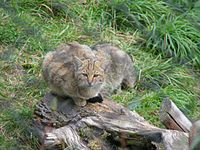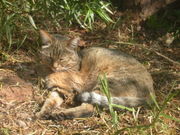Wild cat
2007 Schools Wikipedia Selection. Related subjects: Mammals
| iWild Cat | ||||||||||||||
|---|---|---|---|---|---|---|---|---|---|---|---|---|---|---|
 European Wild Cat
|
||||||||||||||
|
|
||||||||||||||
 Least Concern (LC) |
||||||||||||||
| Scientific classification | ||||||||||||||
|
||||||||||||||
|
|
||||||||||||||
| Felis silvestris Schreber, 1775 |
||||||||||||||
|
|
||||||||||||||
|
See text |
The wild cat (Felis silvestris), sometimes "wildcat" or "wild-cat" especially when distinguishing from other wild species of felines, is a small predator native to Europe, the western part of Asia, and Africa. It is a hunter of small mammals, birds, and other creatures of a similar size. There are several subspecies which occur in different world regions, including also the ubiquitous domestic cat (Felis silvestris catus), which has been introduced to every habitable continent and most of the world's larger islands, and has become feral in many of those environments.
In its native environment, the wild cat is adaptable to a variety of habitat types: savanna, open forest, and steppe. Although domesticated breeds show a great variety of shapes and colours, wild individuals are medium-brown with black stripes, between 50 and 80 cm (20–32 inches) in length, and weigh between 3 and 6 kilograms (6–13 pounds). The African subspecies tends to be a little smaller and a lighter brown in colour.
Wild cats are extremely timid. They avoid coming too close to human settlements. They live solitarily and hold territories of about 3 km² each.
Subspecies
African subspecies:
- Felis silvestris brockmani (East Africa)
- Felis silvestris cafra (Southern Africa)
- Felis silvestris foxi ( West Africa)
- Felis silvestris griselda ( Central Africa)
- Felis silvestris libyca African wild cat (North Africa)
- Felis silvestris ocreata (East Central Africa)
- Felis silvestris pyrrhus (West Central Africa)
- Felis silvestris cafra (Southern Africa)
Asian subspecies:
- Felis silvestris caudata (Caspian Sea area)
- Felis silvestris ornata Indian desert cat (India to Iran)
- Felis silvestris shawiana (China and Mongolia)
- Felis silvestris ornata Indian desert cat (India to Iran)
European subspecies:
- Felis silvestris cretensis Cretan wildcat ( Crete) (extinct, though some sightings have been reported).
- Felis silvestris caucasia Caucasian wild cat ( Caucasus Mountains and Turkey)
- Felis silvestris grampia Scottish wild cat (northern and western Scotland)
- Felis silvestris jordansi Balearic wild cat ( Balearic Islands)
- Felis silvestris reyi Corsican wild cat ( Corsica)
- Felis silvestris sarda Sardinia and Sicily wild cats ( Sardinia and Sicily)
- Felis silvestris silvestris European wild cat (Europe)
- Felis silvestris tartessia Southern Spanish wild cat ( Iberian Peninsula)
- Felis silvestris caucasia Caucasian wild cat ( Caucasus Mountains and Turkey)
Domestic cat:
- Felis silvestris catus Domestic cat ( cosmopolitan)
European wild cat
The European wild cat (Felis silvestris silvestris) inhabits forests of Western, Central and Eastern Europe, as well as in Scotland and Turkey; it is not found in Scandinavia, Iceland, England, Wales, or Ireland. Its physical appearance is much bulkier than that of the desert cats and domestic cats. The thick fur and size are distinguishing traits; a wild cat normally would not be mistaken for a domestic cat. In contrast to domestic cats, they are most active in the daytime.
Wild cats were common in the European Pleistocene era; when the ice vanished, they became adapted to a life in dense forests. In most European countries they have become very rare. Although legally protected, they are still shot by hunters taking them for domestic cats. In Scotland, interbreeding with feral cats is also a threat to the wild population. It is not known to what extent the interbreeding has affected or replaced the wild population, and although some have claimed that there are no "pure" wild cats left at all, there is still considerable disagreement.
Two subspecies coexisted in large numbers in the Iberian Peninsula: the common European subspecies, F. s. silvestris, north of the Douro and Ebro rivers, and the giant Iberian subspecies F. s. tartessia, in the rest of the territory. The last is one of the heaviest subspecies of Felis silvestris; In his book Pleistocene Mammals of Europe ( 1963), palaeontologist Dr. Björn Kurtén noted that this subspecies conserves the same size of the form that lived in all Europe during the Pleistocene. Although Spain and Portugal are the West European countries with the greatest population of wild cats, the animals in these region are threatened by breeding with feral cats and loss of habitat.
African wild cat
The African wild cat or desert cat (Felis silvestris libyca) is distributed over deserts and savannahs of Africa and the Arabian peninsula. It is considerably smaller than the European subspecies and has shorter fur. The African wild cat is believed to be the ancestor of the domestic cat, since it is tamer than the European wild cats and active at night.
Although some authorities claim that domestication of cats took place as early as 8000 BC, the oldest indisputable evidence is Egyptian depictions from about 4000 BC. However, a 2004 discovery in Shillourokambos, Cyprus provides strong evidence of at least the taming, if not domestication, of wild cats circa 7500 BC.
Asiatic wild cat
The Asiatic wild cat, Asian steppe wild cat or Indian desert cat (Felis silvestris ornata) primarily inhabits the Rajasthan desert and in Rann of Kutch in India. It is about the size of a domestic cat with a pale yellowish body marked with black spots. This is currently an endangered species partly due to poaching for its prized skin.
